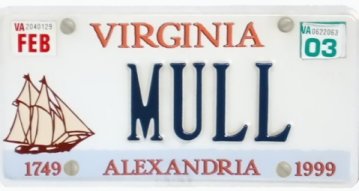



Sorely, You Must be Joking
At the very front end of this let me state that at the Louvre (LOOV-rah) there arepictures of women without their shirts but (a) there are not that many, (b) they are all about 600 years old, and (c) there are at least as many statues of men without their shorts. The Louvre is an equal opportunity museum.
The Louvre portion of the travelogue will be included in Friday's Mullings. I am more time-zoned than I thought.
---
There are some important points to be made regarding walking around Paris. First amongst these is the point which should be self-evident - almost nothing is written in English. I say this should be self-evident but nothing is self-evident to me because I'm not usually paying attention.
This lack of common communication capability leads to many, many misunderstandings. For instance, I thought that this was the place where that potato dish was available for purchase on the installment plan.
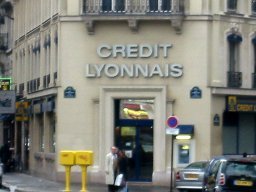
But, when I went in to get some, they told me, I think, they had no potatoes. In fact, they looked at me and said "Monsieur pomme de tÍte."
See what I mean?
The river which runs through Paris is called the Seine. This is pronounced, for reasons which completely escaped me, "sane."
They make the biggest possible deal over the fact that the Seine - a river, remember - has two banks. A Left Bank (Rive Gauche) and a Right Bank (Rive, uh, something else).
This is on the Left Bank. And that is on the Right Bank. And I wish I lived on the Left Bank. And I like the shops on the Right Bank.
Well, duh.
Everyriver has two banks. A river without two banks is called
- an ocean. Hell-OH-oh!
You know, now that I am thinking about banks and all that potato place might have been ... nah.
Anyway, everything in Paris is either on the Right Bank or the Left Bank of the Seine. The Left Bank is the side which has the reputation of having all the lovers and literary types hanging around gazing at all the cultural stuff.
Yeah? Well riddle me this, Batman. Why is the Louvrfe on the Right Bank and the Ministry of Defense on the Left Bank?
We're waiiiiiting.
Here's another thing which confuses the casual visitor. The street names.
Here's a little attention getter:

Guess what, Todo? We're not in The Bronx anymore.
A nice thing about street signs is, on many of them which are named after a person, they tell you what the person did to get the street named after him.
As an example:
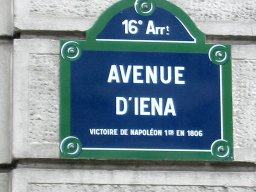
"Victoire," in French, I think means "Surrendered to."
Anyway, I was walking to the Louvre and I decided my feet hurt and my legs were tired. I had several choices. One was to sit on the curb on cry which I didn't want to do because of the previously mention habits of Parisian dogs.
Another was to hail a cab. But, the business about cabs is, you have to have some common language. In the case of taxi cabs in the Western Hemisphere the common language is Ethiopian in which, I am a little rusty.
The third choice was the Metro which is what they call the subway in Paris. And almost every place else they have a subway except for New York (where it is called "The Subway") and San Francisco where it is named, unaccountably, for Homer Simpson's son.
There are many, many maps of the Metro system which, you will be told, is very old but very efficient. You can get from anywhere to anywhere on the Metro.
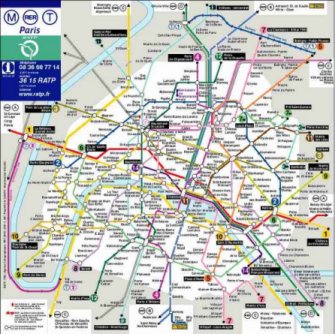
The problem with the maps is they all look like a schematic drawing of a nuclear particle accelerator at the Lawrence Livermore National Laboratory. With some patience and a fairly strong magnifying glass - on the order of the Hubble Space Telescope - you can generally figure out where you are, where you want to go, and how to get there.
What you can't find out is: How much the Metro costs. As a public service here's how it works.
You walk down some steps under a sign which says "Metro" or "Metropolitain" thus:
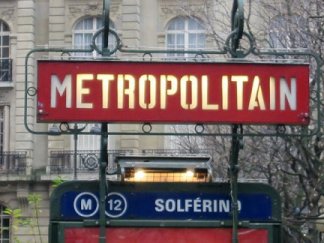
You go to the ticket window. You hold up one finger (the index finger seemed to work, but to be honest I didn't try any of the others). You give the woman behind the window some money. She gives you some money back.
That's how much the Metro costs.
Anyway once you get on the Metro you can, truly, go from anywhere to anywhere in Paris. The trip from where I started to the Louvre required a change of lines at the Franklin Delano Roosevelt station.
While I was waiting for the train to the Louvre station, I came across some people pointing to one of the large maps on the wall. They were pointing to the Charles V station (Charles V is pronounced Sharl Sank. Why they would have a station named after a decaf coffee is something which I didn't have time to discover.) Because I had been in the Metro for seven minutes and had successfully transferred from one line to another, I pointed out that we were not at the Sanka station, but at the FDR station.
The small group - obviously tourists - were extremely grateful for my help. It turned out they were from Italy and spoke better Italian, better French andbetter English than I did.
Sure enough the train came: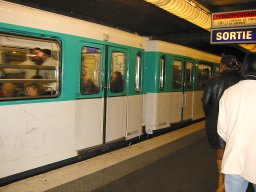
and, while there were no seats available, it did take me directly to the Louvre.
A sidebar about the Paris Metro. Every guidebook -- every guidebook warns tourists to be on guard against pickpockets in the Paris Metro. For the entirety of this walkabout I was wearing a trenchcoat which, I felt, made me look like 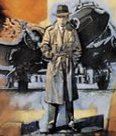
Humphry Bogart when he and Ingrid Bergman "always had Paris."
It did not. It, my map and my camera made me look like a short, heavy, middle-aged American tourist.
Nevertheless on my way back from the Louvre later that afternoon a woman with a baby asked me how to get to the Concorde station. I took her to the map and pointed it out.
When I was bragging about my comfort with the Paris Metro system that night, someone suggested she was probably a staller for a group of pickpockets who were foiled because even I would feel someone reaching down to my calfs, lifting up my trenchcoat, and pulling my wallet out of my pocket.
No good deed ...
Continued.
Next, I promise, my trip to the Louvre.